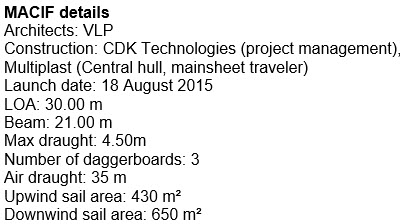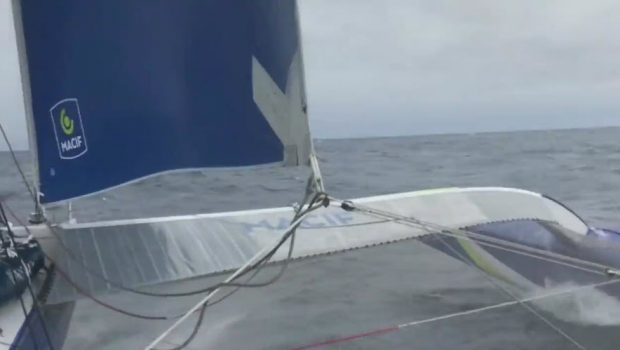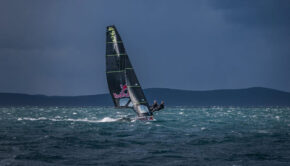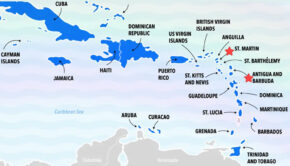Gabart looking toward Cape Horn
Published on December 1st, 2017
(December 1, 2017; Day 28, 18:00 FR) – François Gabart continues to make excellent pace toward Cape Horn in his attempt to set a new singlehanded round the world record. The skipper of the 30m MACIF trimaran has covered 796.6 nm in the past 24 hours and has increased his margin to 930.24 nm ahead of the record pace.
 After four weeks at sea, Gabart has managed to reposition himself ahead of a low-pressure system and is planning to round Cape Horn between late December 3 or early on December 4.
After four weeks at sea, Gabart has managed to reposition himself ahead of a low-pressure system and is planning to round Cape Horn between late December 3 or early on December 4.
“The wind speed is currently at 35 to 38 knots: the wind has only just picked up and the sea isn’t too bad,” reports Gabart. “I’m making quick progress between 30 and 45 knots. It isn’t easy to maintain a regular speed. I’m trying my best, but I’m not going to complain as things are headed in the right direction and at a good pace.
“Since the beginning of the South Seas, I’m either ahead or behind a low-pressure area. We don’t yet have a boat sufficiently fast to overtake these phenomena particularly when the wind speed is 50 knots. These last three days, I was behind. It was tough, because there wasn’t much I could do except slow down if I didn’t want to take a beating. Now, I’m ahead. I need to sail sufficiently fast to enjoy calmer winds and sea, to prevent any damage. You need to get the delicate balance right.”
“When the wind is strong, you initially try to prevent the boat from overturning, so I’m careful about that. The sheets aren’t far, ready to be to eased off and the automatic release system is also in operation. Otherwise, the wave impacts are really tricky.
“The overall goal, and the hardest one, is to maintain as stable a speed as possible, because when things are happening very fast, there comes a time when you stop in a wave and the boat goes under and it’s very violent. So, the aim is to sail fast on average, without any peak speeds.
“Otherwise, I regularly check the boat to see that none of the parts have moved or if a sail hasn’t unfurled. The two forward headsails, the J1 and the gennaker, are really well secured to the central hull, where they are laid, but when you reach 45 knots in the water and the sail weighs 150 kilos, the strain is colossal. If a strap breaks, things can quickly turn into a nightmare. So, I try to go around the boat as often as I possibly can.
“I got some good rest last night, so I’m not too tired. However, I am being careful about my muscles, because I feel the strain, particularly around the neck. I try to do some good stretching, because I’ve been sailing a few weeks now and I’ve been jolted about in the last few days. It’s difficult to relax your muscles, even in the bunk, because you’re being knocked around in all directions, so I’m careful about that, because I’ve still a few crank turns before the end…
If everything goes well in front of the low, then it’ll be full ahead to Cape Horn. If I manage to stay ahead of the low-pressure area, the sea shouldn’t be too bad. I hope that it will stay like that until the Horn. There is still ice to starboard and we are not going to take any risks, but the weather situation means that we can keep our distance further north.
“I really love the South Seas. It’s magnificent to be sailing here, but it’s always the same. When you get to the end, you’re happy to leave. I’m really dying to get back to the Atlantic, to warmer climes and just to get closer to the finishing line, because the clock is ticking! Afterwards, I know that it’s far from over, that it’s going to be hard work and that the Atlantic will be full of pitfalls, but nevertheless, Cape Horn is a very symbolic place, and I really can’t wait to be there.”
“As for the weather outlook for the Atlantic, I’m taking it for what it’s worth because it’s still quite far off, but it’s looking favourable: quite tough at the start, which is quite good because this will make it easier to get to the northeast. Then, as usual, you have the transition areas facing Argentina and Brazil. I hope that the weather sequence will work out well. For the moment, the lights are looking green, so it’s cool, but let’s get to Cape Horn first with a boat at 100 percent of its capacity.”
Team details – Tracker – Facebook
 Only three sailors to date (Francis Joyon, Ellen MacArthur, Thomas Coville) have ever held the record. After his start on November 4, to beat the record of 49 days, 3 hours, 4 minutes and 28 seconds held by Coville since December 25, 2016, Gabart will need to cross the finishing line (between Créac’h lighthouse, in Ouessant (Ushant), and the Lizard Point lighthouse in Cornwall, England) before 13.09 on December 23 (French time, UTC+1).
Only three sailors to date (Francis Joyon, Ellen MacArthur, Thomas Coville) have ever held the record. After his start on November 4, to beat the record of 49 days, 3 hours, 4 minutes and 28 seconds held by Coville since December 25, 2016, Gabart will need to cross the finishing line (between Créac’h lighthouse, in Ouessant (Ushant), and the Lizard Point lighthouse in Cornwall, England) before 13.09 on December 23 (French time, UTC+1).










 We’ll keep your information safe.
We’ll keep your information safe.